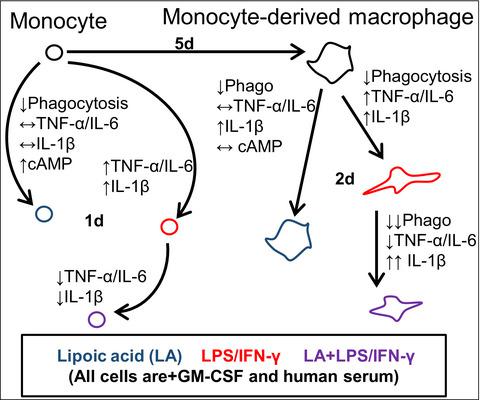当前位置:
X-MOL 学术
›
Immunol. Cell Biol.
›
论文详情
Our official English website, www.x-mol.net, welcomes your
feedback! (Note: you will need to create a separate account there.)
Lipoic acid modulates inflammatory responses of monocytes and monocyte-derived macrophages from healthy and relapsing-remitting multiple sclerosis patients.
Immunology and Cell Biology ( IF 3.2 ) Pub Date : 2020-08-06 , DOI: 10.1111/imcb.12392 Sarah E Fiedler 1 , Rebecca I Spain 1, 2 , Edward Kim 1, 2 , Sonemany Salinthone 1, 2
Immunology and Cell Biology ( IF 3.2 ) Pub Date : 2020-08-06 , DOI: 10.1111/imcb.12392 Sarah E Fiedler 1 , Rebecca I Spain 1, 2 , Edward Kim 1, 2 , Sonemany Salinthone 1, 2
Affiliation

|
Multiple sclerosis (MS) is a disabling neuroinflammatory disease. Its etiology is unknown, but both oxidative stress and inflammation appear to be involved in disease pathology. Macrophages are the predominant cell type in acute inflammatory brain lesions in MS. Macrophages produce proinflammatory and toxic molecules that promote demyelination and are key players in phagocytosis/degradation of myelin sheathes. Lipoic acid (LA) is an inexpensive, endogenously produced small molecule that exhibits antioxidant and anti‐inflammatory effects. Treatment with LA is protective in MS and other inflammatory diseases. To examine the mechanism(s) by which LA may attenuate inflammatory lesion activity in MS, we used healthy control and MS cells to evaluate the effects of LA on levels of inflammatory cytokines, phagocytosis and the immunomodulator cyclic adenosine monophosphate (cAMP) in monocytes and monocyte‐derived macrophages (MDMs). LA treatment resulted in a generally less inflammatory phenotype of monocytes and MDMs from healthy controls, and (to a lesser degree) MS donors. LA inhibited monocyte secretion of cytokines relevant to MS in monocytes, including tumor necrosis factor‐α (TNF‐α), interleukin (IL)‐6 and IL‐1β; LA effects on secretion of these cytokines in MDMs were mixed with inhibition of TNF‐α and IL‐6, but stimulation of IL‐1β, the latter perhaps as a result of altered macrophage polarization. LA inhibited phagocytosis in both monocytes and MDMs, and increased cAMP levels in monocytes. LA may modulate inflammatory cytokine secretion and phagocytosis via a cAMP‐mediated mechanism.
中文翻译:

硫辛酸调节来自健康和复发缓解型多发性硬化症患者的单核细胞和单核细胞衍生的巨噬细胞的炎症反应。
多发性硬化症 (MS) 是一种致残的神经炎性疾病。其病因尚不清楚,但氧化应激和炎症似乎都与疾病病理有关。巨噬细胞是 MS 急性炎症性脑损伤的主要细胞类型。巨噬细胞产生促炎和有毒分子,促进脱髓鞘,并且是髓鞘吞噬作用/降解的关键参与者。硫辛酸 (LA) 是一种廉价的内源性小分子,具有抗氧化和抗炎作用。LA 治疗对 MS 和其他炎症性疾病具有保护作用。为了检查 LA 可能减弱 MS 炎症病变活动的机制,我们使用健康对照和 MS 细胞来评估 LA 对炎性细胞因子水平的影响,单核细胞和单核细胞衍生的巨噬细胞 (MDM) 中的吞噬作用和免疫调节剂环磷酸腺苷 (cAMP)。LA 治疗导致来自健康对照和(在较小程度上)MS 供体的单核细胞和 MDM 的炎症表型通常较少。LA 抑制单核细胞分泌与 MS 相关的细胞因子,包括肿瘤坏死因子-α (TNF-α)、白细胞介素 (IL)-6 和 IL-1β;LA 对 MDM 中这些细胞因子分泌的影响与 TNF-α 和 IL-6 的抑制相混合,但刺激 IL-1β,后者可能是巨噬细胞极化改变的结果。LA 抑制单核细胞和 MDM 中的吞噬作用,并增加单核细胞中的 cAMP 水平。LA 可能调节炎性细胞因子的分泌和吞噬作用 LA 治疗导致来自健康对照和(在较小程度上)MS 供体的单核细胞和 MDM 的炎症表型通常较少。LA 抑制单核细胞分泌与 MS 相关的细胞因子,包括肿瘤坏死因子-α (TNF-α)、白细胞介素 (IL)-6 和 IL-1β;LA 对 MDM 中这些细胞因子分泌的影响与 TNF-α 和 IL-6 的抑制混合在一起,但刺激 IL-1β,后者可能是巨噬细胞极化改变的结果。LA 抑制单核细胞和 MDM 中的吞噬作用,并增加单核细胞中的 cAMP 水平。LA 可能调节炎性细胞因子的分泌和吞噬作用 LA 治疗导致来自健康对照和(在较小程度上)MS 供体的单核细胞和 MDM 的炎症表型通常较少。LA 抑制单核细胞分泌与 MS 相关的细胞因子,包括肿瘤坏死因子-α (TNF-α)、白细胞介素 (IL)-6 和 IL-1β;LA 对 MDM 中这些细胞因子分泌的影响与 TNF-α 和 IL-6 的抑制混合在一起,但刺激 IL-1β,后者可能是巨噬细胞极化改变的结果。LA 抑制单核细胞和 MDM 中的吞噬作用,并增加单核细胞中的 cAMP 水平。LA 可能调节炎性细胞因子的分泌和吞噬作用 包括肿瘤坏死因子-α (TNF-α)、白介素 (IL)-6 和 IL-1β;LA 对 MDM 中这些细胞因子分泌的影响与 TNF-α 和 IL-6 的抑制混合在一起,但刺激 IL-1β,后者可能是巨噬细胞极化改变的结果。LA 抑制单核细胞和 MDM 中的吞噬作用,并增加单核细胞中的 cAMP 水平。LA 可能调节炎性细胞因子的分泌和吞噬作用 包括肿瘤坏死因子-α (TNF-α)、白介素 (IL)-6 和 IL-1β;LA 对 MDM 中这些细胞因子分泌的影响与 TNF-α 和 IL-6 的抑制混合在一起,但刺激 IL-1β,后者可能是巨噬细胞极化改变的结果。LA 抑制单核细胞和 MDM 中的吞噬作用,并增加单核细胞中的 cAMP 水平。LA 可能调节炎性细胞因子的分泌和吞噬作用通过cAMP 介导的机制。
更新日期:2020-08-06
中文翻译:

硫辛酸调节来自健康和复发缓解型多发性硬化症患者的单核细胞和单核细胞衍生的巨噬细胞的炎症反应。
多发性硬化症 (MS) 是一种致残的神经炎性疾病。其病因尚不清楚,但氧化应激和炎症似乎都与疾病病理有关。巨噬细胞是 MS 急性炎症性脑损伤的主要细胞类型。巨噬细胞产生促炎和有毒分子,促进脱髓鞘,并且是髓鞘吞噬作用/降解的关键参与者。硫辛酸 (LA) 是一种廉价的内源性小分子,具有抗氧化和抗炎作用。LA 治疗对 MS 和其他炎症性疾病具有保护作用。为了检查 LA 可能减弱 MS 炎症病变活动的机制,我们使用健康对照和 MS 细胞来评估 LA 对炎性细胞因子水平的影响,单核细胞和单核细胞衍生的巨噬细胞 (MDM) 中的吞噬作用和免疫调节剂环磷酸腺苷 (cAMP)。LA 治疗导致来自健康对照和(在较小程度上)MS 供体的单核细胞和 MDM 的炎症表型通常较少。LA 抑制单核细胞分泌与 MS 相关的细胞因子,包括肿瘤坏死因子-α (TNF-α)、白细胞介素 (IL)-6 和 IL-1β;LA 对 MDM 中这些细胞因子分泌的影响与 TNF-α 和 IL-6 的抑制相混合,但刺激 IL-1β,后者可能是巨噬细胞极化改变的结果。LA 抑制单核细胞和 MDM 中的吞噬作用,并增加单核细胞中的 cAMP 水平。LA 可能调节炎性细胞因子的分泌和吞噬作用 LA 治疗导致来自健康对照和(在较小程度上)MS 供体的单核细胞和 MDM 的炎症表型通常较少。LA 抑制单核细胞分泌与 MS 相关的细胞因子,包括肿瘤坏死因子-α (TNF-α)、白细胞介素 (IL)-6 和 IL-1β;LA 对 MDM 中这些细胞因子分泌的影响与 TNF-α 和 IL-6 的抑制混合在一起,但刺激 IL-1β,后者可能是巨噬细胞极化改变的结果。LA 抑制单核细胞和 MDM 中的吞噬作用,并增加单核细胞中的 cAMP 水平。LA 可能调节炎性细胞因子的分泌和吞噬作用 LA 治疗导致来自健康对照和(在较小程度上)MS 供体的单核细胞和 MDM 的炎症表型通常较少。LA 抑制单核细胞分泌与 MS 相关的细胞因子,包括肿瘤坏死因子-α (TNF-α)、白细胞介素 (IL)-6 和 IL-1β;LA 对 MDM 中这些细胞因子分泌的影响与 TNF-α 和 IL-6 的抑制混合在一起,但刺激 IL-1β,后者可能是巨噬细胞极化改变的结果。LA 抑制单核细胞和 MDM 中的吞噬作用,并增加单核细胞中的 cAMP 水平。LA 可能调节炎性细胞因子的分泌和吞噬作用 包括肿瘤坏死因子-α (TNF-α)、白介素 (IL)-6 和 IL-1β;LA 对 MDM 中这些细胞因子分泌的影响与 TNF-α 和 IL-6 的抑制混合在一起,但刺激 IL-1β,后者可能是巨噬细胞极化改变的结果。LA 抑制单核细胞和 MDM 中的吞噬作用,并增加单核细胞中的 cAMP 水平。LA 可能调节炎性细胞因子的分泌和吞噬作用 包括肿瘤坏死因子-α (TNF-α)、白介素 (IL)-6 和 IL-1β;LA 对 MDM 中这些细胞因子分泌的影响与 TNF-α 和 IL-6 的抑制混合在一起,但刺激 IL-1β,后者可能是巨噬细胞极化改变的结果。LA 抑制单核细胞和 MDM 中的吞噬作用,并增加单核细胞中的 cAMP 水平。LA 可能调节炎性细胞因子的分泌和吞噬作用通过cAMP 介导的机制。











































 京公网安备 11010802027423号
京公网安备 11010802027423号